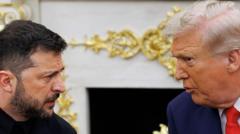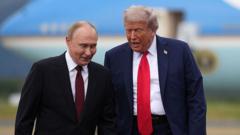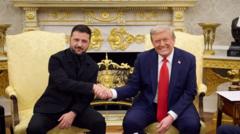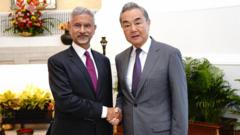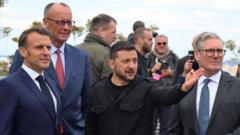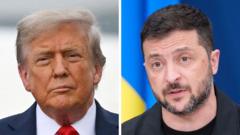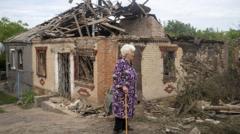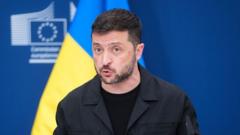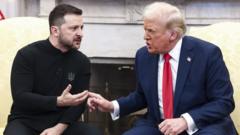President Trump's interpretations of the Ukraine war are being notably influenced by the map displayed in the Oval Office, which delineates the regions under Russian control.
**Oval Office Map Shaping Trump’s Perspective on the Ukraine Conflict**
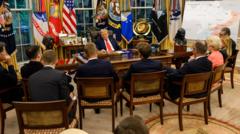
**Oval Office Map Shaping Trump’s Perspective on the Ukraine Conflict**
A Critical Examination of the Visual Tool Influencing Foreign Policy Conversations
The map featured prominently in the Oval Office has served as a focal point in discussions surrounding the Ukraine war, particularly impacting President Donald Trump's perspective. During Monday's talks with Ukrainian President Volodymyr Zelensky, Trump highlighted the map's representation of territory occupied by Russia, which accounts for a substantial fifth of Ukraine. This visual representation, accentuated by the areas painted in red, reinforces the urgency for Ukraine to consider a compromise regarding its territorial claims.
"I assume you've all seen the map," Trump stated, alluding to the stark reality of Russian territorial gains. It suggests a shift in the diplomatic stance towards Ukraine, hinting at potential land swaps or territorial concessions to Vladimir Putin. In response, Zelensky presented his own map during the meeting, emphasizing the precise control dynamics of different regions to mitigate any misconceptions.
Despite Zelensky's efforts to clarify facts surrounding the map's portrayal of territorial control, Trump's assessment remained unchanged. He observed that Russia’s military capabilities continue to dominate the region. Conversations among European leaders, as reported by Trump, have started to circulate around the notion of compromises on territories such as Donbas, which is currently under significant Russian control.
Before Russia's aggression in 2014, Donbas contributed around 16% of Ukraine's economy. Putin's intentions appear to extend beyond mere territorial claims, seeking broad peace deals that could possibly unify Donbas with Russia. The stark statistics showcased on the White House map demonstrate that Russian forces maintain significant presence in various Ukrainian regions, escalating tension over territorial integrity and national sovereignty.
Zelensky later countered Trump's views regarding the map's statistics, which noted varying percentages of Russian control in several crucial areas including Luhansk, Donetsk, and Zaporizhzhia. While strategic estimates align roughly between the US and Ukrainian sources, the apposition in methodologies highlights differing interpretations on Russian control.
Despite reported advancements by Russian forces over the past few months, analysts caution that capturing the full extent of Donetsk will require prolonged military endeavors. Ukraine’s military strategy focuses on defending its territories, evidenced by recent repulsions of attempted territorial invasions.
While Russia continues to reinforce its military presence and accumulate manpower, Ukraine’s resilience prevails in maintaining significant control over the Donbas region. The way both leaders interpret the front lines critical in shaping the ongoing narrative of the war underscores their distinct strategic priorities.
"As we discussed the map, our objectives remain clear," Zelensky remarked post-meeting, emphasizing his intent to reclaim lost territories despite the odds presented. The divergent views highlighted in this crucial dialogue reflect the complex interplay of military realities and diplomatic engagements in the quest to resolve the conflict in Ukraine.
"I assume you've all seen the map," Trump stated, alluding to the stark reality of Russian territorial gains. It suggests a shift in the diplomatic stance towards Ukraine, hinting at potential land swaps or territorial concessions to Vladimir Putin. In response, Zelensky presented his own map during the meeting, emphasizing the precise control dynamics of different regions to mitigate any misconceptions.
Despite Zelensky's efforts to clarify facts surrounding the map's portrayal of territorial control, Trump's assessment remained unchanged. He observed that Russia’s military capabilities continue to dominate the region. Conversations among European leaders, as reported by Trump, have started to circulate around the notion of compromises on territories such as Donbas, which is currently under significant Russian control.
Before Russia's aggression in 2014, Donbas contributed around 16% of Ukraine's economy. Putin's intentions appear to extend beyond mere territorial claims, seeking broad peace deals that could possibly unify Donbas with Russia. The stark statistics showcased on the White House map demonstrate that Russian forces maintain significant presence in various Ukrainian regions, escalating tension over territorial integrity and national sovereignty.
Zelensky later countered Trump's views regarding the map's statistics, which noted varying percentages of Russian control in several crucial areas including Luhansk, Donetsk, and Zaporizhzhia. While strategic estimates align roughly between the US and Ukrainian sources, the apposition in methodologies highlights differing interpretations on Russian control.
Despite reported advancements by Russian forces over the past few months, analysts caution that capturing the full extent of Donetsk will require prolonged military endeavors. Ukraine’s military strategy focuses on defending its territories, evidenced by recent repulsions of attempted territorial invasions.
While Russia continues to reinforce its military presence and accumulate manpower, Ukraine’s resilience prevails in maintaining significant control over the Donbas region. The way both leaders interpret the front lines critical in shaping the ongoing narrative of the war underscores their distinct strategic priorities.
"As we discussed the map, our objectives remain clear," Zelensky remarked post-meeting, emphasizing his intent to reclaim lost territories despite the odds presented. The divergent views highlighted in this crucial dialogue reflect the complex interplay of military realities and diplomatic engagements in the quest to resolve the conflict in Ukraine.

